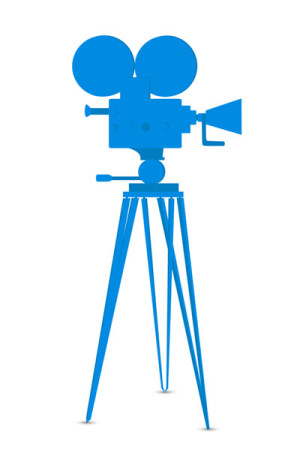
It used to be that any video you could put up was better than no video, but unfortunately, those days are long gone. People are bombarded with so many messages, so many choices and so many ways to receive information, that low quality video will always lose unless the viewer is completely dedicated to receiving your message.
There are several important ways in which you can be hurt by putting out low-quality video, and there are 8 key areas you need to pay attention to, in order to keep your quality high. Let’s have a look.
A bad first impression is hard to overcome.
Whether you like it or not, people form an opinion from their first impression of you. It happens within seconds, and most of the time, they don’t change that original opinion easily, even when presented with new information. If you use a video to welcome people to your website and it doesn’t show you in your best light, you risk losing any chance of making a better impression on your web visitors later on. Very likely, they just won’t be back and whatever you did to attract them was a wasted effort.
Bad videos lower your credibility.
With so many people looking for information on the internet before they take a step like calling you, you have to be very careful about what you put out about yourself. Most people won’t even realize it consciously, but the underlying sentiment is that if you don’t care enough to make a video that’s easy to watch and hear, that’s engaging and that gives them value without wasting their time — why would working with you be any different?
People generalize what they think about your video to what they believe about your area of ‘expertise.’
It’s funny how people carry what they see in one area into another. If you have a really great video, they’re likely to think that you really know your stuff when it comes to the service you offer. Unfortunately, it also works in the other direction — when you have a low quality video, they think your work is low quality, too.
For example, suppose you’re auditioning accountants. If the person you’re talking to makes grammatical errors, or uses words inaccurately it’s easy to jump to the conclusion that he or she isn’t a good accountant, either. Same thing here. Although you’re not auditioning to make videos for people, people are likely to assume that the quality of your video and the level of your expertise are both about the same.
Poor videos represent you poorly.
The videos you make are the vehicle that carry you into the world so that you can spread your message. You may have enough passion to fuel the trip, but it’s not enough.
If you’re riding around in a beat-up clunker that rattles and groans, and smoke is pouring out of the exhaust pipe, that’s what people will notice. Your videos need to be as worthy as your message, if you want to be taken seriously. The vehicle that represents you has to show you in a light that attracts people easily, or they won’t stick around long enough to find out why they should care.
With all these reasons to care about raising the quality of your videos, let’s have a quick look at 8 important areas to focus on and see what some of the questions are, that naturally relate to them.
1. Light
Without enough light, you can’t be seen… without being seen, people can’t get to know you, and that’s the first step in the Know-Like-Trust cycle. Where should lights be positioned? How much do you need? How do you set them up so you look your best without squinting because they’re too bright?
2. Sound
People click away pretty fast when they can’t understand what you’re saying. Competing background noise, echo, hollow sound, buzzing and humming — these are just a few of the things that can compromise the sound on your videos. What kind of mic do you need? Where should you put it? What camera supports a mic like that? What about music — where do you get it, how do you pick it, how do you add it, how loud should it be?
3. Script
The details of whatever you’re talking about are usually a lot more interesting to you than to your audience. Knowing what to say and where it belongs in your video are really important. Should you memorize a script? Should you read a script? Should you forget using a script and risk rambling? Whether you use a script or not, what should you talk about? Where are your ideas coming from? What does this have to do with the value you’re trying to give your audience?
4. Composition
Have you ever noticed how hard it is to watch a video in which the person speaking is lost in the scenery, or isolated against a bare wall? Composition makes a huge difference to the ability of your audience to stay focused on you and your message. What should be in the shot? Should you sit or stand? How close should you be to the wall or to the window? What about those videos where people seem to ‘float’ on the background?
5. Framing
Have you ever watched a video or Skyped with someone who was barely in the picture — you know, where there was so much empty space above their head that you couldn’t help thinking they might slide right out of the video? Or maybe you’ve seen one of those scary shots where the person’s hands are HUGE and coming right at you. Where should you be in the frame? How much of you should show? How far from the camera should you be How do you manage all this if you don’t have help behind the camera?
6. Persona
If you’ve ever seen a commercial for a local business that features an eager beaver OR a deadpan business owner, you know that persona can lead quickly to becoming a local joke, and that’s NOT what you’re aiming at! What do you need to do, to avoid looking ridiculous? How can you be on camera and feel like you? What do you do if you hate being on camera? What do your clothes, hair and makeup have to do with it?
7. Tripod
Seasick. That’s how your audience feels when you never stop moving in the frame and the background is always shifting. If you’re serious about making videos that people will watch, you have to use a tripod. What’s the best way to use one? How much do you have to spend for stability? What does a tripod have to do with the download speed of your video?
8. Editing
You know those videos where you see the person turn the camera on and off? Ouch. It’s so easy to edit that out, make easy-to-watch transitions and add an intro. How do you combine takes? What editing software do you need? How much do you need to spend? How do you pick transitions?
And the good news is…It really isn’t any more difficult to make good videos than to make bad ones!
Once you know what you need to do, it’s just a matter of doing it, and when your audience sees your commitment to making it happen, they’ll love you for it.

If you’re ready to make high-quality videos, my friend Steven Washer is the man you want to know. He’s a patient and masterful guide through a maze of equipment, skills and other variables that most of us don’t even know enough to think about, let alone bother to get any good at!
I’ve learned so much from him that I want you to work with him, too — because if you know you need raise the quality of your videos, he’s the best choice you can make!
He’s just released a series of free videos designed to help you attract clients… just click here to get started.
If you’re making videos, don’t make ones that sell you short… get the help you need from an expert who really cares!

